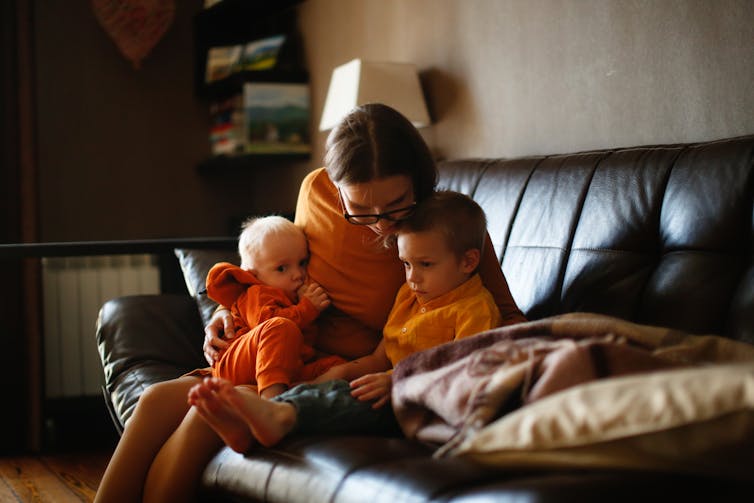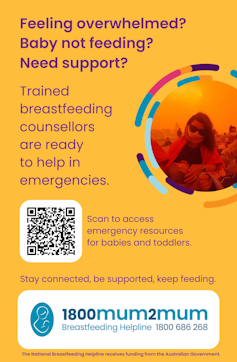
Bushfires currently burning in Victoria, New South Wales and Tasmania bring into sharp focus the fire risks Australian families face over the coming summer months.
Although babies don’t understand the nature of emergencies such as bushfires, floods and cyclones, they and their mothers are impacted.
During natural disasters, electricity, clean water and food supplies may be interrupted, and gastroenteritis is common. At these times, breastfeeding provides babies with safe food, water, and protection from infection, as well as a feeling of comfort and safety.
But mothers can find it difficult to breastfeed during emergencies, and may believe stress affects their milk supply. Some end up stopping even though they didn’t plan to and even though during a disaster is a particularly bad time to wean.
The good news is stress doesn’t reduce milk supply, and while breastfeeding during an emergency carries added challenges, mothers can and do breastfeed through even the worst of disasters.
Demand and supply
During pregnancy, hormones develop the milk-making structures inside women’s breasts. After birth, the breasts automatically make milk to feed the baby, but over time they change to a demand and supply way of working.
This means that when the baby feeds and milk is removed from the breasts, the breasts make more milk. The more frequently milk is removed from the breasts, the more milk will be made.
Babies drink the milk made in the breasts with the help of a hormone called oxytocin. When babies suckle, oxytocin tells the muscle-like cells that surround the small structures where milk is made and stored to contract. This squeezes the milk towards the nipple where the baby can drink it.
Oxytocin is sometimes called the “love hormone” because it’s also produced when you feel lovingly towards someone.
Read more: I regret stopping breastfeeding. How do I start again?
Stress doesn’t impact milk production
There isn’t any way for stress to interfere with the demand and supply process of milk making.
However, mothers often worry that the stress of an emergency has reduced their milk supply. Usually, this is because they are noticing their baby’s behaviour has changed.
During emergencies, babies are often more unsettled, want to be held more, feed more frequently, may be fussy at the breast, and wake more overnight. All of this is a normal response to the disruption of an emergency.
Although stress won’t hamper a mother’s milk supply, it can temporarily reduce oxytocin release, slowing the flow of milk. This is another reason a baby may be unsettled during feeding.
Some challenges
Emergencies like bushfires and floods are difficult for everyone, but can be especially challenging for parents of babies and toddlers.
For breastfeeding mothers, the busyness of an emergency and a lack of privacy may mean they miss their baby’s cues or delay breastfeeding. Less frequent breastfeeds can reduce milk supply.
Another factor that can affect milk supply is dehydration. Mothers may not drink enough water during an emergency because they’re focused on looking after their children, water is limited, or they are restricting water intake because there are no toilets.
How can I keep breastfeeding through an emergency?
Expect your baby to breastfeed more often than usual during an emergency. They may breastfeed for comfort as well as food. Keeping your baby close, breastfeeding frequently, and drinking enough water will protect your milk supply.
Know the signs that your baby is getting enough milk. If they have at least five heavily wet nappies in 24 hours, their wee is pale (not dark) in colour, and their poo is runny if they are only breastfed or soft if they are also eating solid foods, you can be confident your baby is getting enough breastmilk.

You can encourage the release of oxytocin and the flow of milk when you breastfeed by looking at your baby and thinking about how much you love them. This can also help you feel less stressed.
You can be reassured that if your milk supply has decreased because of less frequent breastfeeding or dehydration this can be easily reversed by feeding more often and drinking water. If you stopped breastfeeding because of an emergency, it’s possible to start again if you want to.
If you are concerned about your milk supply, seek help from a health worker. The free national breastfeeding helpline is available 24/7 and is a good place to find support.

Preparing for an emergency
Make an emergency plan that includes packing an evacuation kit, leaving early and evacuating to a relative or friend’s home rather than an evacuation centre if possible. Ensure your evacuation kit includes a baby sling to keep your baby safe and close, and some water and snacks for you.
If you are exclusively expressing milk, learn how to hand express and cup feed (even very young babies can be fed using a cup). Store some paper cups so you have all you need if you are without power and water for washing.
Read more: Evacuating with a baby? Here's what to put in your emergency kit
Anything emergency responders can do to reduce the burden of the emergency on mothers, such as prioritising them for services and offering them private spaces in evacuation centres, will help them to care for and breastfeed their babies. A free e-learning module for emergency responders on disaster support for babies, toddlers and their caregivers is available here.
Karleen Gribble is Project Lead on the Australian Breastfeeding Association's Community Protection for Infants and Young Children in Bushfire Emergencies Project and is an Australian Breastfeeding Association Scientific Advisor, Educator and Counsellor. Karleen is also on the steering committee of the international interagency collaboration the Infant and Young Child Feeding in Emergencies Core Group and has been involved in the development of international guidance and training on infant and young child feeding in emergencies for over a decade. She is a member of the Public Health Association of Australia.
Michelle Hamrosi is the Community Engagement Officer on the Australian Breastfeeding Association's Community Protection for Infants and Young Children in Bushfire Emergencies Project. Michelle is also a General Practitioner and an International Board Certified Lactation Consultant, as well as a Clinical Lecturer for the Australian National University’s Rural Medical School. Michelle volunteers as an ABA Breastfeeding Counsellor and Group Leader for the Australian Breastfeeding Association Eurobodalla Group. She is also a member of Doctors for the Environment, Climate and Health Alliance and Australian Parents for Climate Action.
Nina Chad is the Infant and Young Child Feeding Consultant for the Department of Nutrition and Food Safety at the World Health Organization. She has been a volunteer breastfeeding counsellor for the Australian Breastfeeding Association for more than 20 years.
This article was originally published on The Conversation. Read the original article.







